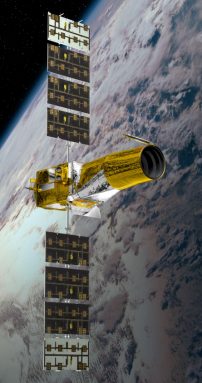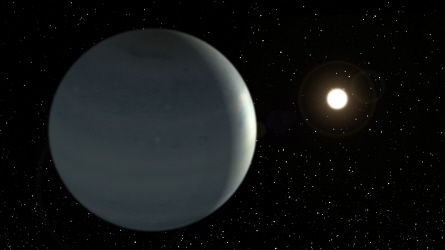Cool as a Jupiter
New-found, far-out planet could be similar to local gas giants.
Astronomers have found more than 400 planets outside the solar system. These distant worlds are full of surprises: Some are giant and made of gas, like Jupiter, and others seem to be rocky, like big versions of Earth. All these faraway orbs are called exoplanets — short for “extrasolar” planets because they’re outside our solar system — and astronomers find more all the time.
Scientists recently found an exoplanet that’s really cool — literally. Most exoplanets are much hotter even than the gas giants in our solar system (Jupiter, Saturn, Uranus and Neptune). But the newly discovered planet, called COROT-9b, is different. Its temperatures don’t soar as high, and as a result it’s probably more like Jupiter and Saturn than other known exoplanets are. (The planet was first spotted by the COROT telescope, which is why “COROT” is in its name.)
 |
|
Illustrated here, the COROT satellite orbits Earth and scans the skies for planets that are beyond the solar system.
|
| D. Ducros; CNES (French National Space Agency) |
On COROT-9b, the low temperatures on the surface are around -23º Celsius (-9.4º degrees Fahrenheit) and the highs reach 157 º C (314 º F). COROT-9b is 1,500 light years away. (A light year is the distance light can travel in one year, or about 5.9 trillion miles.)
Other planets have been found with lower temperatures, but COROT-9b is special for another reason. It “transits” its star, which means it passes directly between its star and the Earth. Astronomers can learn more about a distant planet that transits than they can about a planet that doesn’t transit. So when a transiting planet shows up, the scientists get excited.
 |
|
An artist’s conception of the new-found planet orbiting its star.
|
| Gabriel Pérez/ Servicio Multimedia (IAC) |
Hans Deeg, who worked on the new study of COROT-9b, says this is the first time a cooler planet has been found to transit. Deeg works at the Instituto de Astrofísica de Canarias in Tenerife, Spain. Most transiting planets are “weird — inflated and hot,” Didier Queloz, another scientist who worked on the study, told Science News. Queloz works at the Geneva Observatory in Sauverny, Switzerland.
As a planet passes in front of its star, it blocks out some light. (This is sort of like a solar eclipse, when the moon passes between the Earth and the Sun.) When astronomers measure the blocked light, they can quickly calculate the size of the planet.
They can also learn about the atmosphere of a transiting planet. The light that comes from the star is made of waves — in fact, it’s made of many waves of different wavelengths. Each different wavelength is a different color, even though all together the waves look white. As this light passes through the atmosphere of the exoplanet, different kinds of atoms absorb different wavelengths of light. Eventually that light reaches Earth. By measuring which wavelengths are “missing,” astronomers can figure out which atoms in the atmosphere absorbed the light.
Even though COROT-9b is cooler than many other exoplanets, it’s probably not habitable. That means it’s too early to pack your bags because people can’t live there. But, as Sara Seager, an exoplanet expert at MIT, told Science News, if this planet has a rocky moon, there may be hope of finding a new planet to call home.
And even if things don’t work out with COROT-9b, there are other worlds to consider, worlds much closer to home. The study of exoplanets is just getting started: hundreds may have been found, but scientists think there are millions of new worlds in our galaxy, just waiting to be discovered.
Time to start planet hunting!
Going Deeper:
Cowen, Ron. 2010. “This exoplanet is so cool,” Science News, March 17. http://sciencenews.org/view/generic/id/57377/title/This_exoplanet_is_so_cool
Keep up with exoplanet news: http://exoplanets.org/
Ornes, Stephen. 2009. “One ring around them all,” Science News for Kids, November 11. http://sciencenewsforkids.org/articles/20091111/Note2.asp







